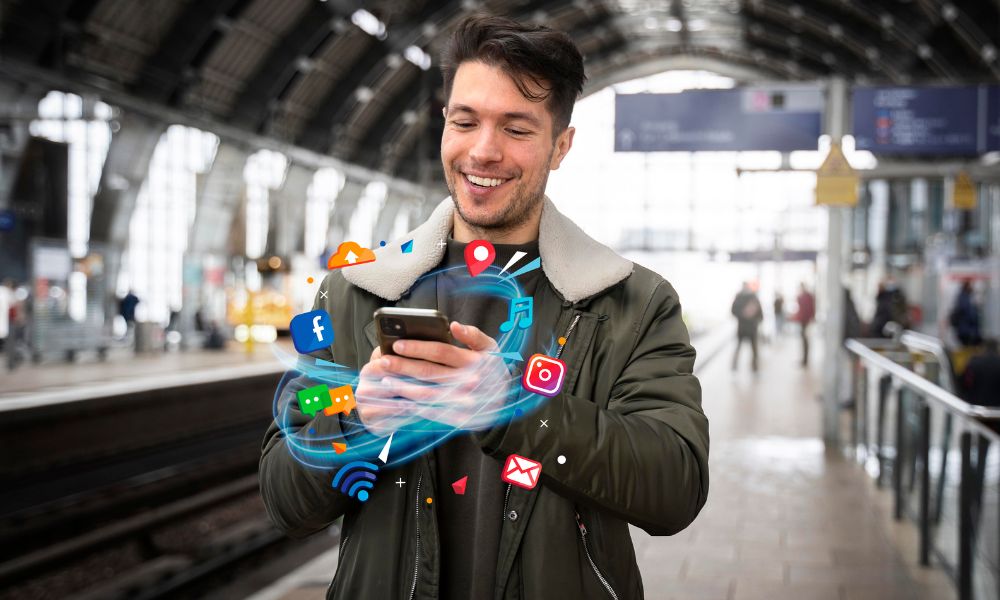
You launched a successful influencer campaign. The content was great, and the metrics looked good. But after it ended, the engagement dropped off, and the new followers never became loyal customers. Sound familiar?
This is the universal pitfall of modern influencer marketing. Brands treat collaborations as one-off transactions, accessing an audience but never building a relationship with it. This approach leaves most of the value on the table.
These are the people who already trust, follow, and listen to the creators you partner with. If you can turn that connection into a conversation, and that conversation into loyalty, you’re no longer just borrowing an influencer’s spotlight. You’re building a community of brand fans who believe in what you do.
The solution is a strategic shift to actively engage with influencer audiences. This means moving beyond a single post to create a lasting connection between their community and your brand. It’s about turning borrowed interest into owned loyalty.
Let’s explore how to transform passive viewers into active participants and lifelong brand fans.
What Does “Engaging with Influencer Audiences” Truly Mean?
At its core, engaging with influencer audiences is a fundamental shift in mindset. It’s the deliberate move from buying reach to building a relationship. While a large follower count might look impressive on a media kit, it’s the active, trusting community within that audience that holds the real value for your brand.
Think of it this way: an influencer hasn’t just built a list of followers; they’ve built a community founded on trust and authenticity. Their audience trusts their recommendations because of a genuine, long-standing connection. When you simply pay for a post, you are a temporary guest in that community. But when you actively and respectfully engage with that influencer’s audience, you are introducing yourself as a valued new member. You are showing that you respect the community’s dynamics and want to contribute to it, not just extract from it.
This shift from a transactional to a relational approach directly impacts your bottom line. When you earn the trust of an influencer’s audience, you are not just improving brand perception. You are strategically positioning your brand to drive higher conversions and foster the kind of deep loyalty that turns one-time buyers into passionate brand advocates.
Why Ignoring the Audience Is Your Biggest Influencer Marketing Mistake
It’s a painful scenario: you invest your budget in a creator with excellent content and strong numbers, yet the campaign fails to deliver sustainable results. The problem often isn’t the influencer, it’s that you left their audience on the table.
Treating an influencer campaign as a simple media buy, where the post is the final deliverable, is the single most costly error a brand can make. You are paying a premium for access to a pre-qualified, trusting community, but you are only capturing a fraction of its potential value. This is like paying for a personal introduction at a networking event, only to walk away immediately after the handshake.
When you ignore the audience after the content goes live, you create a strategic leak in your marketing funnel. You generate fleeting awareness, but you fail to build the connection that turns viewers into customers and customers into fans. You are essentially starting from scratch with every single campaign, forever renting an audience instead of building one you own.
This mistake turns a potential goldmine of long-term loyalty into a one-time cashout. The audience is ready to connect; the biggest mistake is not being there to meet them.

The Competitive Edge of Authentic Audience Engagement
When you engage directly with influencer audiences, you move from simply “being seen” to being remembered. Visibility can get you attention, but engagement builds preference. It’s what turns a one-time viewer into a repeat buyer, and a passive follower into a vocal brand advocate.
Here’s why authentic audience engagement gives your brand an undeniable edge.
1) Builds Brand Credibility Through Creator Trust
Influencers earn their authority through consistency and connection. Their audience follows them because they trust their voice, not because of algorithms or ads. When your brand partners authentically with those creators, that trust extends to you. It’s a credibility transfer that no traditional campaign can replicate.
But this only works when the collaboration feels natural. A product that genuinely fits the influencer’s lifestyle reinforces credibility; one that doesn’t risks eroding it. The closer the alignment, the stronger the bridge between the influencer’s trust and your brand reputation.
2) Boosts Conversions Because Engaged Followers Take Action
Engaged audiences aren’t passive observers, they respond. They click, comment, share, and buy because the recommendation comes from someone they already know and like. Studies consistently show that conversions from influencer-driven engagement outperform standard paid ads, especially when the audience feels emotionally connected.
The key is timing and context. When the audience sees your brand involved in meaningful conversations or responses, they don’t just see marketing, they see participation. That subtle difference is what drives action.
3) Amplifies Word-of-Mouth and Organic Reach
When engagement is real, it doesn’t stop at the influencer’s post. It spreads. Followers tag friends, re-share stories, and start their own threads. That’s how your brand begins to live in the feed and in the conversation.
This kind of organic amplification is priceless. It keeps your campaign visible long after the initial collaboration ends, turning one partnership into an ongoing awareness loop that costs you nothing extra.
4) Provides Measurable Impact Beyond Vanity Metrics
Likes and impressions look impressive, but they rarely tell the full story. Engagement opens the door to metrics that actually matter, comment sentiment, referral clicks, conversions, and repeat interactions. These are indicators of genuine connection, not surface-level attention.
By tracking how audiences interact with influencer content, brands can finally tie performance to ROI. You’re no longer guessing what worked, you’re proving it with data.
Authentic audience engagement is what modern influencer marketing is built on. It’s not louder marketing, it’s smarter marketing, rooted in trust, conversation, and measurable impact.

The 7 Key Tactics to Engage Influencer Audiences Meaningfully
Understanding the “why” is crucial, but the “how” is where you gain your competitive edge. The following seven tactics will help your brand connect with influencer audiences in ways that feel natural, trustworthy and effective, turning casual followers into active participants.
Tactic 1: Select Influencers Whose Audience Aligns with Your Brand Values
Before anything else, choose influencers who genuinely connect with your ideal customer. It’s not just about follower count, it’s about audience fit. Look for creators whose tone, interests, and values align with your brand’s message. When there’s overlap between their community and your target market, engagement becomes effortless.
Use tools like Hypefy’s Influencer Discovery Tool to analyze demographics, engagement quality, and sentiment. The right partnership begins with alignment, not assumption.
Tactic 2: Co-Create Content That Resonates with the Influencer’s Community
The most successful campaigns feel like a seamless extension of an influencer’s usual content. Involve creators in the process, from brainstorming to execution. They know what their audience reacts to best.
Co-created campaigns tend to outperform scripted briefs because they preserve authenticity. Let the influencer tell your story in their voice, not yours. This approach earns trust instead of forcing attention.
Tactic 3: Encourage Interactive Formats: Lives, Q&As, and Behind-the-Scenes
Passive content gets passive results. Active content builds a community. Prioritize formats that invite real-time participation. Host a live Q&A session with the influencer to answer audience questions directly. Run a poll in their stories to choose a product feature. Share a behind-the-scenes look at your collaboration. These formats break the fourth wall and create shared, interactive experiences.
If you want to improve how you collaborate with creators long term, explore our guide on Influencer Relationship Management, where we cover how to build productive partnerships that keep audiences engaged consistently.
Tactic 4: Use Calls-to-Action That Feel Natural, Not Forced
The best CTAs are the ones that sound like friendly suggestions, not sales pitches. Instead of “Buy now,” try “Check out what I’ve been using lately” or “You can find more details in the link below.”
This kind of soft CTA matches the tone of influencer content and keeps the recommendation genuine. When the action feels organic to the conversation, engagement happens without resistance.
Tactic 5: Facilitate Audience-Driven Content: Testimonials, Takeovers, Stories
Turn influencer audiences into co-creators. Encourage followers to share their own experiences, whether that’s a quick review, a tagged story, or participation in a challenge.
User-generated content not only amplifies your reach but also strengthens community ownership. When followers become part of the story, they become emotionally invested in your brand’s success. For deeper insight on tracking this engagement, explore How to Measure Influencer Marketing Success.
Tactic 6: Foster Community Beyond the Post with Replies and Referrals
The work begins after the post is published. Have a dedicated team member (or use a tool) to monitor the comments and respond thoughtfully. Thank people for their kind words, answer their questions, and engage in the conversation. To extend this further, create a referral program that rewards fans for bringing their friends into your brand’s community, turning one-off engagers into a self-sustaining growth loop.
Tactic 7: Monitor and Adapt in Real Time: Feedback Loops and Trends
A successful engagement strategy is agile. Use social listening tools to monitor the sentiment and questions coming from the audience. Is there a common concern you can address? Is a particular aspect of your product generating excitement? Feed these insights back to the influencer for a follow-up post or use them to adapt your ongoing strategy. This shows you are listening and value their input, solidifying the relationship.

Channel & Platform Nuances: Tailoring Your Engagement Strategy
Every social platform has its own culture, pace, and audience behavior. The way people engage on Instagram is not the same as TikTok or YouTube, and your influencer strategy should reflect those differences. When you tailor your approach to the platform, you meet the audience where they already feel comfortable, which makes every interaction smoother and more genuine.
Instagram & Reels: Visual Storytelling and Quick Reactions
Instagram is a visually-driven platform where aesthetics and narrative matter. Engagement here is fast and emotive.
How to Engage: Focus on high-quality visuals and compelling storytelling in Reels and carousel posts. Use Stories for polls, quizzes, and the “question” sticker to drive direct interaction. The key is speed, respond to comments quickly and use emoji-heavy replies to match the platform’s energetic tone. Prompting users to “save” the post if they find it helpful or “share” it with a friend in DMs can also boost algorithmic reach and peer-to-peer endorsement.
TikTok: Live Collaborations, Trending Sounds, and Native Creator Engagement
TikTok is built on trends, authenticity, and a sense of community participation. The audience expects to be part of the content.
How to Engage: Lean into trends, sounds, and memes that the influencer’s audience is already following. The most powerful tactic is the Duet and Stitch features, which allow the audience to directly interact with and respond to the influencer’s content. Host live sessions with the influencer for real-time Q&As. Engagement here should feel raw, unpolished, and deeply integrated into the platform’s collaborative culture.
YouTube: Longer Form Content, Creator Discussions, and Deeper Community Building
YouTube fosters a dedicated, high-trust community around long-term creator relationships. The audience invests significant time, seeking deeper connection and value.
How to Engage: The comment section on YouTube is a primary community hub. Facilitate detailed discussions by asking open-ended questions in the video. The influencer can pin your brand’s comment to kick-start a conversation. Encourage the creator to speak authentically about their experience with your product in a longer, review-style format. Engaging here means providing thoughtful, substantive replies to comments and even creating follow-up content based on audience questions from the video.
LinkedIn & Twitter: Professional Influencer Networks, Niche Audiences, and High Trust
On these platforms, “influencers” are often industry thought leaders. Their audiences are niche, professional, and value expertise and insight above all else.
How to Engage: The approach must be more professional and value-driven. Instead of a hard sell, focus on knowledge sharing. The influencer can create detailed threads on Twitter or long-form articles on LinkedIn discussing an industry problem your product solves. Your engagement should be equally insightful, contribute to the comment thread with valuable data, ask intelligent questions, and share the post with your own professional network. Trust is built through demonstrated expertise, not entertainment.

How to Measure Engagement with Influencer Audiences and Tie It to Business Outcomes
If you can’t prove the value, you can’t justify the investment. When it comes to influencer marketing, engagement is the clearest window into how audiences respond, interact, and ultimately convert. But meaningful engagement is more than likes on a post. It’s the combination of trust, participation, and action that shows whether an influencer’s community is becoming your community.
Engagement is only the first step. Understanding how to move audiences from interaction to action is just as important. If you want a full framework for this journey, our Influencer Marketing Funnel guide breaks down every stage from awareness to conversion.
Here is how to measure it in a way that actually helps your brand grow.
Key Metrics: Engagement Rate, Comment Quality, Audience Sentiment, and Shared Content
Forget likes and follower counts. Your dashboard should focus on indicators of genuine relationship-building.
- Engagement Rate: Calculate this as (Likes + Comments + Saves + Shares) / Reach. A high rate signals content resonance.
- Comment Quality: Are comments just emojis, or are they asking thoughtful questions? Phrases like “Where can I buy this?” or “How long does shipping take?” indicate high purchase intent.
- Audience Sentiment: Use social listening tools to categorize comments and mentions as positive, negative, or neutral. A surge in positive sentiment is a powerful brand health indicator.
- Shared Content & User-Generated Content (UGC): Track how often the audience shares the influencer’s post to their own Stories or creates their own content featuring your product. This is the ultimate form of advocacy.
Influencer-Audience Fit: Relevance, Trust, and Participation Over Pure Follower Numbers
Instead of asking “How many followers does the influencer have?” start asking “How does their audience behave?”. A smaller creator with a loyal, active community often outperforms a large account with shallow engagement.
- Relevance: Do the influencer’s usual topics and their audience’s interests logically connect to your brand?
- Trust: Does the audience actively seek the influencer’s opinion in comments? Do they respond to calls to action?
- Participation: Is the community highly interactive, or are they passive scrollers? A smaller, participatory audience is far more valuable than a large, silent one.
Connecting Engagement to Action: Clicks, Conversions, and Community Growth
Engagement is the bridge, but action is the destination. Track what happens after the interaction.
- Are followers clicking through to landing pages?
- Are they completing purchases or signing up for something?
- Do they return later through retargeting?
- Are they joining your own community spaces or following your brand channels?
This is the critical link. You must connect online interactions to tangible business results.
- Trackable Links & Codes: Use unique UTM parameters, discount codes, and affiliate links for every influencer. This directly ties website clicks, sign-ups, and sales to the campaign.
- New Follower Source & Quality: Monitor if you gain new followers on your own channels from the campaign. More importantly, track if these new followers are engaging with your brand after the initial campaign ends.
- Repeat Purchases: Analyze your customer data to see if customers acquired through influencers make a second purchase. This demonstrates a successful transition from a one-time buyer to a loyal customer.
Avoid Vanity Metrics – Focus on Meaningful Interactions
High impressions and like counts look impressive in a report, but they rarely tell the full story. Focus instead on metrics that show real interest and intention, such as detailed comments, saved posts, or creator-driven conversations.
Meaningful engagement is what drives organic visibility, long-term relationships, and ultimately, revenue. Vanity metrics may feel good, but meaningful metrics help you make better decisions.

Build a Community, Not Just a Customer List
Influencer marketing is no longer about one-time promotions or quick bursts of visibility. The real impact comes from engaging with influencer audiences in a way that feels genuine, thoughtful, and consistent. When you shift your focus from chasing views to building relationships, everything changes. You attract followers who trust your brand, talk about your products, and return again because they feel connected to your story.
Brands that thrive today are the ones investing in community, not just campaigns. They collaborate with the right creators, show up in conversations, respond to real people, and treat engagement as a long-term asset rather than a metric to report. That approach turns influencer content into something more powerful, a shared experience that grows your reach and your reputation.
In the end, the goal is simple. Do not just collect customers. Build a community that believes in your brand, advocates for it, and grows with it. That is the future of influencer marketing, and it starts with every meaningful interaction you create today.
For a comprehensive framework that covers all aspects of proving value, from attribution models to calculating true ROI, read our guide on How to Measure Influencer Marketing Success.



